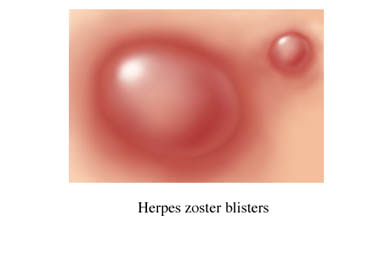|
HapaVir - Viral Replicating Inhibitor |
Shingles and supplementing with HapaVir™
Definition
Shingles is a painful skin rash. It is caused by the varicella zoster virus. Shingles usually appears in a band, a strip, or a small area on one side of the face or body. It is also called herpes zoster. Shingles is most common in older adults and people who have weak immune systems because of stress, injury, certain medicines, or other reasons. Most people who get shingles will get better and will not get it again. Causes It is caused by the varicella zoster virus. This is the same virus that causes chickenpox.
Risk Factors These risk factors increase your chance of developing shingles. Tell your doctor if you have any of these risk factors:
Shingles is not usually transmitted from one person to another. But, a person who has never had chickenpox and never received the varicella vaccine is likely to get chickenpox if he came in prolonged contact with a person who has shingles. Covering shingles sores with a bandage reduces the risk of transmitting shingles to others. People who may live with you, or may be required to be in close proimity to you while you have a case of shingles should consider also taking HapaVir™, until your outbreak has cleared. If you have any of these symptoms do not assume it is due to shingles. These symptoms may be caused by other conditions. Tell your doctor if you have any of these:
The rash disappears within three weeks. The pain may continue months or years after the rash has healed. This is called postherpetic neuralgia (PHN). PHN pain is difficult to treat. It can also be very severe. Diagnosis The doctor will ask about your symptoms and medical history. A physical exam will be done. Your doctor can diagnose the rash by its appearance. Fluids may be drawn from the blisters for testing but this is rare. Treatment Shingles cannot be cured. Treatment is focused on:
Suggest use for Shingles: Take 2 tablets every 4 hours at the first signs of infection. Itch and Pain Relief Itching may be relieved by:
Over-the-counter pain relievers:
Your doctor may prescribe drugs to relieve pain that doesn't respond to over-the-counter remedies.
| |
Statements have not been evaluated by the Food and Drug Administration. These products are not intended to diagnose, treat, cure or prevent any disease. The information provided on this site is intended for your general knowledge only and is not a substitute for professional medical advice or treatment for specific medical conditions. Always seek the advice of your physician or other qualified health care provider with any questions you may have regarding a medical condition. The information on this website is not intended to diagnose, treat, cure or prevent any disease. Never disregard medical advice or delay in seeking it because of something you have read on the this site. Product sold on this site are for personal use and not for resale. All orders placed through this website are subject to HapaVir.net acceptance, in its sole discretion. This means that HapaVir.net may refuse to accept, or may cancel, any order, whether or not it has been confirmed, without liability to you or any third party. HapaVir.net reserves the right to discontinue any program or offer. |
|
|
|
|
|
Should you encounter a problem placing your order, feel free to contact us at info@hapavir.net
| © 2012-2014 HapaVir Inc. All Rights Reserved |
